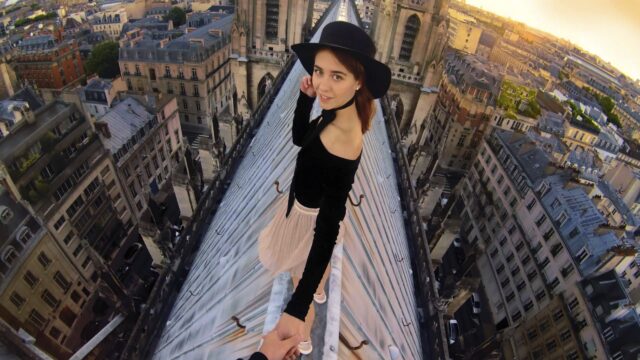The new Netflix documentary “Skywalkers: A Love Story” takes viewers to wild, vertigo-inducing heights
Spectacle, spires and romance: The ‘real suspense’ behind Netflix doc ‘Skywalkers: A Love Story’By LINDSEY BAHRAP Film WriterThe Associated Press
It started out as a film about rooftoppers.
The risk-takers who pose atop the world’s tallest buildings, without safety nets or permission, had long been a fascination for filmmaker Jeff Zimbalist. He’d dabbled in the activity, on a smaller scale in his youth, and was fascinated to learn that it had become a global phenomenon on social media.
One rooftopper who stuck out was Angela Nikolau, notable for being one of the few women operating in the space. She introduced him to Ivan Beerkus, a fellow rooftopper who she’d begun doing joint posts with. Together, they were fascinating and good on camera.
“We didn’t know what the finish line was,” Zimbalist said in a recent interview with The Associated Press. “We really took a leap of faith on this.”
But in the making of “ Skywalkers: A Love Story,” now streaming on Netflix, Zimbalist quickly realized that there was something bigger happening with his subjects: They were falling in love.
This, he knew, was the story. The vertigo-inducing spectacle was the backdrop.
And like illegally climbing an under-construction skyscraper, nothing was going to be simple or straightforward about the mission of putting it all together. In total, the small team spent six years making the film, traveling to six countries with Nikolau and Beerkus to capture their attempts to pose on top of the likes of the 1,957-foot (596.6-meter) Goldin Finance 117, in Tianjin, China, and the 2,227-foot (679-meter) Merdeka 118 in Kuala Lumpur, Malaysia.
The film begins in a tense moment in Merdeka: They’re trying to get to the top undetected. They’re scared. And their relationship is on the line.
Behind the scenes was the inherent danger of it all: The trespassing aspect takes on a different kind of gravity in strict countries like Malaysia. Add in the difficulties of continuing production through COVID and Russia’s war on Ukraine, the logistics of filming without distracting, and the constant conversation about trust — not only between filmmaker and subjects but between the subjects themselves.
“They’d only been doing short form,” Zimbalist said. “The idea that we wanted access to all of the stuff in between their perfect, polished, finished poses was a new concept to them.”
Nikolau was already relatively famous by the time Zimbalist got in touch. Born in Moscow to circus performer parents, she began amassing a large social media following by posting photos of herself on the top of buildings in acrobatic poses. Beerkus was too, for his more “extreme” photographs and films. They were both ardently solo acts. But when they started climbing and posing together, around the time when Zimbalist and his team began to follow them, their popularity grew. Prior to the Netflix debut, she had over 730,000 followers on Instagram, and he had over 236,000.
“We wanted to give it all to this project like we always do,” Beerkus said through Maria Bukhonina, who co-directed the film and translated their interview. “But it was unusual when the cameras started following us everywhere.”
One place they weren’t being followed, however, was to the top of the spires or cranes. The filmmakers had made an agreement with their families to only go to the base roof with their verité cameras so as not to distract. Those shots were all done by the subjects themselves.
“They rigged themselves with body cams and night vision and GoPros and selfie sticks. Ivan’s a master drone operator. And Angela really started to understand what coverage was,” Zimbalist said. “They’re credited as extreme cinematographers in the film.”
Another essential lynchpin was Bukhonina, who was born in Russia, and became the main conduit to the subjects during the pandemic. She and their small camera crew were on the road with them for years.
“We felt they were different from other subjects in the extreme space,” Bukhonina said. “Many athletes like this and in the Red Bull space kind of deny that they have any fear of death. But Ivan and Angela talked about their fears.”
Both filmmakers like to say, this isn’t a film about the fear of falling from heights. It’s a film about the fear of falling in love.
“It doesn’t matter if you don’t make it to the top of Merdeka,” Zimbalist said. “The real suspense of this movie is, is Angela going to ultimately choose to trust Ivan?”
In recent years there’s been several high-profile documentaries chronicling the lives and exploits of extreme athletes and daredevils, including Alex Honnold in “ Free Solo.” Nikolau and Beerkus ignored the suggestion to watch that one and “Man on Wire” to get a sense of what a longform documentary was like. Their first foray was watching their own film.
“We saw how unusual our life is,” Nikolau said. “We always thought of ourselves as a normal, typical couple. Seeing that from the side kind of gives us a new perspective.”
Beerkus added: “We liked all the choices that the directors of the film made because they were able to grasp the real essence of our relationship and what’s going on in there.”
In the days after this interview, Nikolau and Beerkus moved from Thailand to New York. They have big dreams to explore other art forms. She likes to paint. He likes to write music.
“We don’t put any limits on ourselves,” Beerkus said.

COMMENTS
Please let us know if you're having issues with commenting.